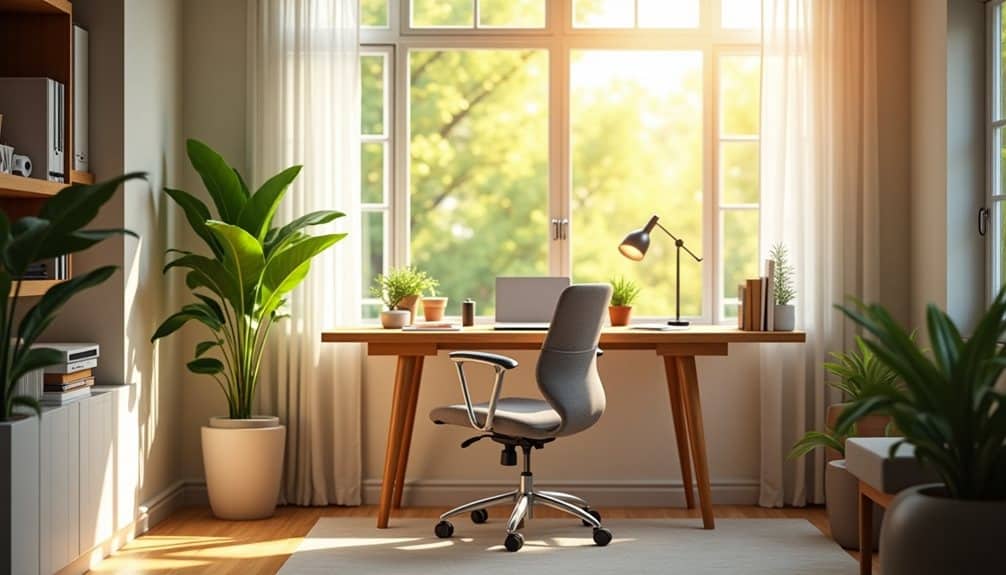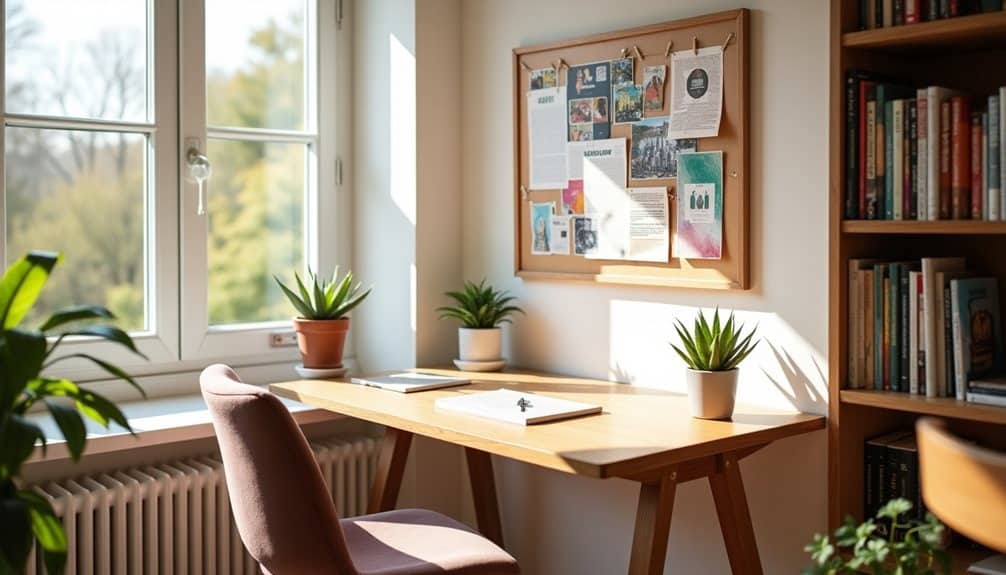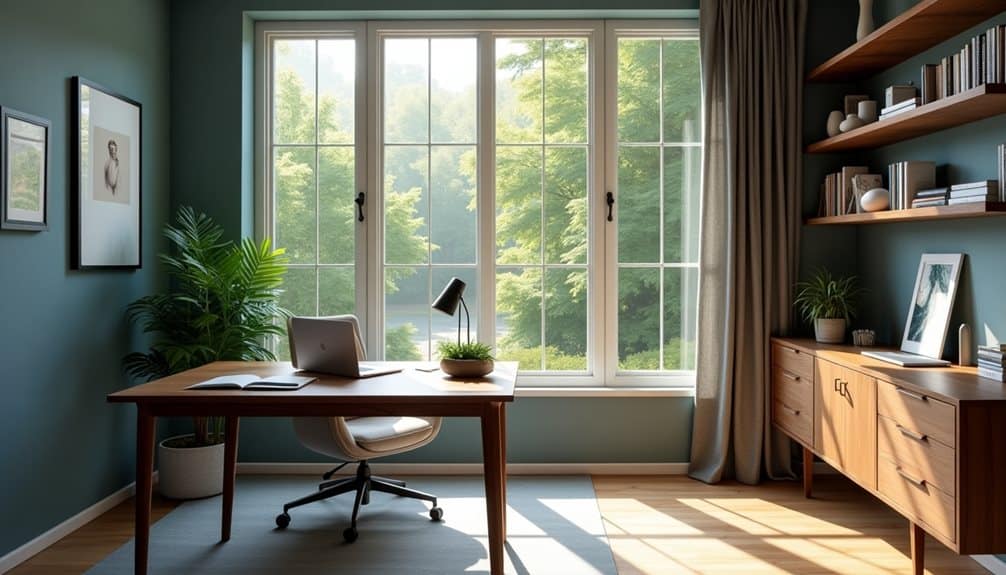Creating a home office that boosts productivity starts with selecting the right location, ideally one filled with natural light and away from distractions. Essential furniture, like an ergonomic chair and a well-designed desk, foster comfort and efficiency. Incorporating personal touches, such as motivational artwork and a cohesive color scheme, ignites inspiration. Additionally, implementing organization systems minimizes clutter, allowing for clarity and focus. As these elements harmonize, the workspace transforms, revealing untapped potential for success. More insights await.
Choosing the Right Location for Your Home Office

Designing a home office that enhances productivity involves careful planning and thoughtful choices. The foundation starts with selecting the right location—preferably an area rich in natural light and isolated from household distractions. This helps maintain focus and boosts energy throughout the workday. Incorporating ergonomic furniture like a supportive chair and an adjustable desk ensures comfort, reducing physical strain during long hours. Adding personalized elements such as inspiring artwork, plants, or a well-coordinated color scheme can create a motivating atmosphere. Meanwhile, efficient organization systems keep clutter at bay, allowing for mental clarity and seamless workflow. When these components come together, the home office becomes a space that nurtures creativity, concentration, and productivity.
Choosing the Right Location for Your Home Office
Selecting the optimal location for your home office is critical to your work performance and well-being. Ideally, the space should receive ample natural sunlight, which regulates circadian rhythms and improves mood and alertness. Studies show that exposure to daylight can increase productivity by up to 15%. The office should be positioned in a quiet part of the home, away from high-traffic areas like kitchens or living rooms, to minimize interruptions.
Consider spaces like a spare bedroom, attic, or a quiet corner near a window. The layout should allow for easy organization and accessibility of work materials. Additionally, good ventilation and comfortable temperature control contribute to maintaining focus and comfort during working hours. Noise reduction strategies—such as using rugs, curtains, or noise-canceling headphones—further improve concentration by blocking out distracting sounds.
Essential Furniture for Maximum Comfort and Efficiency
Choosing the right furniture is vital in creating an effective home office. The desk serves as the centerpiece; it should be spacious enough to hold your computer, documents, and other essentials without feeling cramped. Desks with adjustable heights allow you to alternate between sitting and standing positions, promoting better posture and reducing the risks associated with prolonged sitting, such as back pain or poor circulation.
An ergonomic chair is equally important. Look for features like lumbar support, adjustable armrests, seat height, and tilt mechanisms to cater to your body’s needs. Investing in a high-quality chair can prevent musculoskeletal problems and improve concentration by reducing discomfort.
Incorporate smart storage solutions such as filing cabinets, shelves, or drawer units to keep your workspace tidy and free of distractions. Organized spaces reduce stress and save time searching for materials. Consider also adding cable management tools to keep wires neat and out of the way.
By combining these elements—strategic location, ergonomic furniture, personalized decor, and smart organization—you can create a home office that not only supports productivity but also promotes your overall health and satisfaction during work hours.
Optimizing Lighting and Ergonomics
Although often overlooked, the interplay of lighting and ergonomics plays an essential role in enhancing home office productivity. Natural light invigorates the workspace, reducing eye strain and fostering creativity. Strategically positioned windows can transform an ordinary office into a vibrant environment. Meanwhile, adjustable furniture complements this dynamic; it allows individuals to tailor their workspace to their unique needs, promoting comfort and reducing physical discomfort.
| Aspect | Benefits |
|---|---|
| Natural Light | Enhances mood and focus |
| Adjustable Furniture | Promotes good posture |
| Task Lighting | Reduces eye fatigue |
| Color Temperature | Influences alertness |
Incorporating these elements harmonizes the workspace, ultimately paving the way for greater freedom and productivity.
Personalizing Your Workspace for Inspiration

Enhancing a workspace with personalized elements significantly boosts motivation and creativity. By carefully choosing color schemes that resonate with individual tastes, a home office can transform into an inspiring and vibrant sanctuary. For example, soft pastels such as light blues or greens are known to evoke a sense of calmness and relaxation, which can reduce stress and improve focus. On the other hand, bold hues like reds, oranges, or yellows tend to increase energy levels and stimulate the brain, encouraging dynamic thinking and innovation. Studies in color psychology support these effects, showing how different colors impact mood and cognitive function.
Incorporating motivational quotes—whether framed elegantly or handwritten on decorative paper—serves as a constant reminder of one’s goals and potential. These affirmations, placed alongside inspiring artwork or meaningful personal photographs, help create an atmosphere rich in positive energy. Research suggests that exposure to positive affirmations can reduce stress and boost resilience, which is essential for sustained productivity and creativity.
A truly personalized workspace reflects an individual’s identity, embedding elements that inspire and invigorate. This fosters a sense of freedom and authenticity, encouraging creative thinking without constraints. The harmonious blend of color, inspirational content, and personalized decor cultivates an environment where productivity thrives, and ideas flow freely.
Implementing Organization Systems to Reduce Clutter
Transforming a cluttered workspace into an orderly environment significantly enhances efficiency and focus. One crucial step is embracing digital decluttering, which involves systematically organizing digital files, deleting unnecessary documents, and optimizing storage solutions like cloud services. This practice frees up mental space, reducing cognitive overload and allowing for improved concentration.
Physical organization is equally important. Integrating aesthetically pleasing yet functional storage solutions—such as elegant shelving units, stylish file organizers, and decorative boxes—makes it easier to maintain order while enhancing the workspace’s visual appeal. Each storage element should serve a dual purpose: practical use and personal style expression. Using color-coded folders, labeled containers, or drawer organizers streamlines access to essential items, saving time and minimizing frustration. According to productivity experts, an organized workspace fosters mental clarity, reduces decision fatigue, and helps maintain consistent work habits.
Establishing Boundaries to Minimize Distractions
While maintaining an organized workspace is foundational for productivity, setting clear boundaries is equally critical to minimizing interruptions. Establishing designated work hours helps individuals manage their time effectively, separating professional tasks from personal life. This reduces the risk of burnout by ensuring regular breaks and downtime.
Implementing a digital detox during non-work hours—such as turning off notifications or limiting social media use—helps maintain focus and mental well-being. Research shows that excessive multitasking and frequent digital interruptions impair cognitive performance and creativity. Creating physical boundaries in the workspace, such as using room dividers or noise-canceling headphones, can also reduce external distractions. Together, these practices create an environment conducive to deep work, enabling individuals to achieve their goals more efficiently while maintaining a healthy work-life balance.
| Boundary Type | Description |
|---|---|
| Physical Space | Designate a specific area for work. |
| Time Constraints | Set specific hours for work tasks. |
| Digital Limits | Disconnect from social media during work. |
| Noise Control | Use noise-canceling headphones or soft music. |
| Break Scheduling | Incorporate regular breaks to recharge. |
Such boundaries not only cultivate focus but also nourish the spirit of freedom that remote work can offer.















